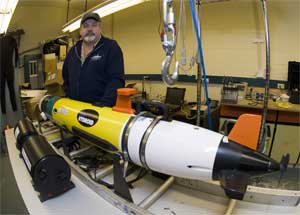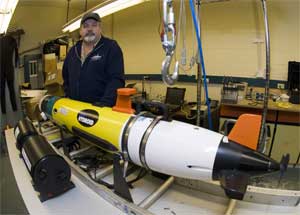 NARRAGANSETT, R.I. – July 18, 2012 – A University of Rhode Island oceanographer will receive a share of a $2 million federal grant to the Northeastern Regional Association of Coastal Ocean Observing Systems (NERACOOS) to operate a nutrient sensing lab at the Graduate School of Oceanography. The lab will oversee the deployment, operation and data processing of nutrient sensors installed on buoys and other observation platforms in Narragansett Bay and Long Island Sound.
NARRAGANSETT, R.I. – July 18, 2012 – A University of Rhode Island oceanographer will receive a share of a $2 million federal grant to the Northeastern Regional Association of Coastal Ocean Observing Systems (NERACOOS) to operate a nutrient sensing lab at the Graduate School of Oceanography. The lab will oversee the deployment, operation and data processing of nutrient sensors installed on buoys and other observation platforms in Narragansett Bay and Long Island Sound.
“Nutrients are important because they influence the growth of plankton, which ultimately contributes to eutrophication and leads to low oxygen levels,” explained Al Hanson, URI marine research scientist.
Nutrients have historically been monitored in Narragansett Bay through the collection of water samples that are later analyzed in a laboratory. According to Hanson, a new technology has been developed using submersible chemical analyzers to measure the nutrients automatically and send the results in real time over the Internet.
“This technology hasn’t been fully implemented yet, so the grant will enable us to demonstrate that it can be done,” Hanson said.
There are currently 13 monitoring stations in Narragansett Bay that continually collect temperature, salinity, oxygen, chlorophyll and meteorological data to help environmental managers monitor the health of the ecosystem. The nutrient sensors have been tested at the URI Bay Campus pier and will be installed on some of the monitoring buoys in the Bay, starting with one located near Conimicut Point later this summer.
Hanson said that the data from the monitoring stations is regularly used by the National Oceanic and Atmospheric Administration, the Environmental Protection Agency, the Rhode Island Department of Environmental Management and university researchers.
“Fishermen and shipping companies also use the data from offshore buoys to gather weather conditions, the Coast Guard uses it for search and rescue operations. The information is really useful to a lot of groups,” said Hanson.
The URI scientist is also working to get the network of Narragansett Bay monitoring sites linked up with the NERACOOS website (www.neracoos.org), which will expand opportunities for additional funding.
“To make these observations sustainable, it will be advantageous for Rhode Island to be connected to NERACOOS,” said Hanson, who represents URI as a member of the board of directors of NERACOOS and chair of its strategic planning and implementation team.
A regional component of the U.S. Integrated Ocean Observing System, NERACOOS spans coastal waters from Nova Scotia and New Brunswick to Long Island Sound. Its mission is to provide those who use these waters with information, including weather and ocean data to the fishing and shipping industries so that they may determine if conditions are safe for passage and to emergency managers issuing storm warnings. NERACOOS is also advancing efforts to use this data for water quality monitoring, harmful algal bloom predictions and warnings, and coastal flooding and erosion forecasting systems.
NERACOOS received $2,032,393 from the National Oceanic and Atmospheric Administration in the second year of a five-year award. The majority of the funding is distributed to its operational and research partners to sustain the data collection and forecasting efforts of the program. In addition to URI, these partners include the University of Maine, Gulf of Maine Research Institute, University of New Hampshire, University of Massachusetts at Dartmouth, University of Connecticut, and Bedford Institute of Oceanography.
Photo by Mike Salerno.

